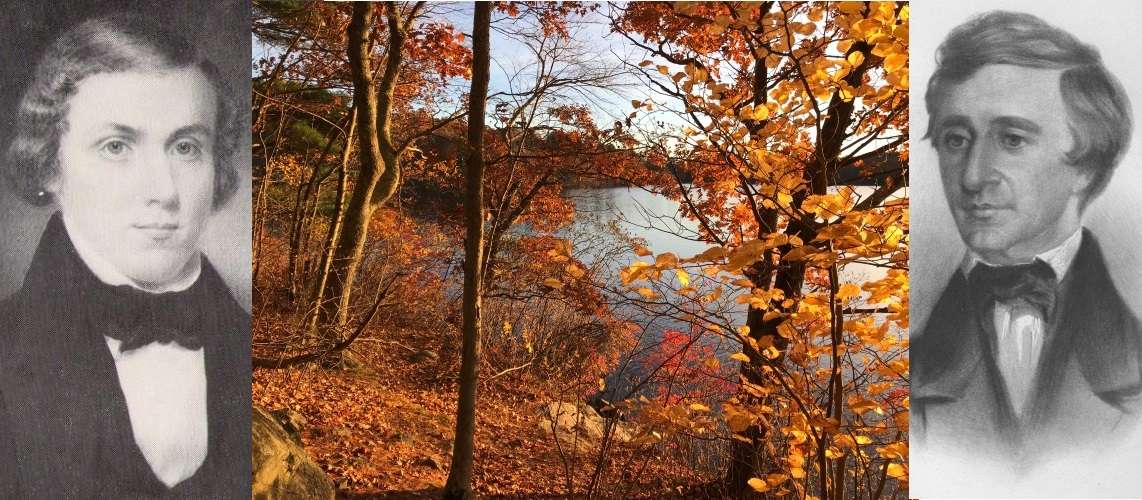An amateur archaeologist, Jeff Craig, may have discovered the lost Wheeler-Thoreau shanty site. The 19th-century shanty helped inspire Thoreau to build his famous cabin at Walden Pond.
Henry David Thoreau spent six weeks in 1837 with his Harvard roommate Charles Stearns Wheeler at this shanty in Lincoln, Mass. A year earlier, Wheeler and his family had built the shanty on their property at Flint’s Pond.
Ralph Waldo Emerson and his back-to-nature Transcendentalist philosophy partially motivated them to pursue this outdoor living experiment.
The Wheeler-Thoreau Shanty
It is widely accepted today that Thoreau got the idea to build his cabin from his experiences at Wheeler’s shanty. Thoreau may have also helped Wheeler build the shanty.
Later, in the early 1840s, Thoreau sought to build a cabin at Flint’s Pond. However, he could not get permission from a landowner. Only after Emerson let him use a small parcel of his land in 1845 did Thoreau build his cabin at Walden Pond.
In modern times, the location of the Wheeler-Thoreau shanty site had been lost; its whereabouts were a complete mystery.
Intrigued with the challenge of finding this historic site, Jeff Craig began researching the history of the Wheeler-Thoreau shanty in 2013. One source stated the site was on a reedy island in the middle of Flint’s Pond. Multiple sources gave conflicting location information, making the search even harder.
After five months, Craig found the possible shanty site just off the shore of Flints Pond.
Discovery
This site had a stone foundation underground, and archaeologists were consulted to help evaluate it. The foundation was identified as a dry stone foundation, one built without mortar. But definitive evidence that it was the actual Wheeler-Thoreau shanty site remained elusive.
A breakthrough occurred in the summer of 2017, when Jeff Craig discovered important evidence at the site. The artifacts he found were evaluated as consistent with a shanty structure that was used as a permanent living quarters.
A key discovery was the identification of a cistern at the site, which was used to collect rainwater, purify it, and provide good drinking water. The discovery of the cistern was unexpected, and it provided strong evidence that the builders of this shanty size stone foundation had included the cistern because people were living there.
The fact that the site was also located in the area where a biography about Charles Stearns Wheeler had described it to be (written by John Eidson in 1951, with assistance from the Wheeler family at the time) offered compelling justification the actual site had been found. The site is also located on land the Wheeler family owned in the early 19th century.
Archaeologists from five major universities have contributed advice and technical assistance to advance the scientific evaluation of this site. None of these archaeologists have worked on this project continuously; their participation was primarily in an advisory role.
Due to the continuing scientific research at the site, the exact location will remain confidential for the foreseeable future.
Transcendentalist Inspiration
A written record of why Wheeler built the Wheeler-Thoreau Shanty has never been found. But when he built the shanty in 1836, Wheeler viewed Emerson as a Transcendentalist mentor. Emerson published his famous essay Nature in September of that year.
Emerson probably also influenced Wheeler and Thoreau in carrying out their Transcendentalist outdoor living experiment the following summer. Besides Thoreau, Wheeler also hosted other Harvard friends at his shanty, including Charles Hayward and Samuel Hildreth. Wheeler later wrote short biographical notices memorializing Hayward and Hildreth in the Christian Examiner (in 1839), as both his friends suffered early deaths related to typhus.
Wheeler used the shanty for six years, from 1836-1842. He also served as the Greek tutor and a History instructor at Harvard for four years, from 1838-1842. Wheeler also helped Emerson edit works by Thomas Carlyle and Alfred Tennyson for their first publication in America (Carlyle’s Sartor Resartus and Tennyson’s Poems).
The Wheeler-Thoreau shanty site, located off the shore of Flints Pond, has a beautiful view of the pond and its surroundings. The location and the pond view have similarities with Thoreau’s cabin site at Walden Pond.
Undoubtedly, the beautiful setting of the shanty influenced Thoreau and helped inspire him to build his own cabin. The six weeks Thoreau lived at Wheeler’s shanty had a profound influence on him, changing his destiny forever.
For more information about the Wheeler-Thoreau shanty project, click on this web address:
https://sites.google.com/view/wheeler-thoreaushanty/





3 comments
[…] If you enjoyed this story, you may also want to read about the probable discovery of the Wheeler-Thoreau shanty, a predecessor to the Walden Pond cabin, here. […]
The original “Small House”!
[…] conducting research about the history of the “lost” shanty in early 2013, Craig spent several months searching for the site near Flint’s Pond. After identifying a possible shanty site foundation underground, archaeologists were brought in […]
Comments are closed.